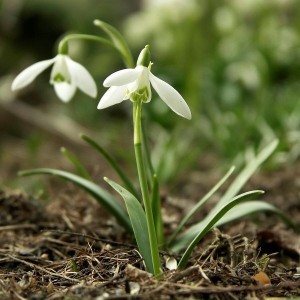 |
This beautiful snowdrop poem is a great example of personification poetry, whilst including some alliteration in the refrains, and one example of word play (leaves) |
As winter fades above you,
Your crown pokes through the ground;
You tentatively peep and take
A regal look around.
Good morning little snowdrop, so full of hope and grace.
How wonderful to welcome your gentle smiling face.
You stretch to reach the sunlight
With a gracious, sylphlike yawn.
Your confidence is growing;
Hope of spring begins to dawn.
Good afternoon young snowdrop, so full of peace and love
How wonderful to welcome you to the world above.
The snow has disappeared,
And winter turns and leaves.
You wave farewell revealing
Your long and slender sleeves.
Good day my little snowdrop, so delicate and fine
How wonderful to welcome you into this heart of mine.
You sway in celebration,
Lightly dancing in the breeze.
The weather has a delicate
And sudden tiny sneeze.
Good evening humble snowdrop; I’m so pleased that you’re here.
You bring a breath of life to the beginning of the year.
I wrote this poem specifically to demonstrate personification in a way that children could understand. (Click here to see this poem with the examples of personification highlighted.) However, in the meantime I learned a new word (sylphlike) which means ‘graceful, slender, moving with ease’. This word is so appropriate that I felt it should be part of the poem, but needed explanation.
I am keen for children always to realise that we are always learning new vocabulary. It’s good to use new words, so long as we first learn and understand what they mean so that we use them properly. I discovered my new word whilst using www.rhymezone.com which gives rhymes, definitions, synonyms and antonyms for any word you ask, and is a great way to increase your vocabulary as you write. I looked for a synonym (a word which means the same) for graceful so that I didn’t repeat myself, and I wanted it to have 2 syllables so that it fitted the rhythm pattern. Try using www.rhymezone.com yourself by clicking here.
If you would like to understand more about what personification is, or find some ideas of how to teach or practice personification, look at the TEACHERS’ PAGE, FIGURATIVE WRITING, PERSONIFICATION for more help.
Comments on this entry are closed.